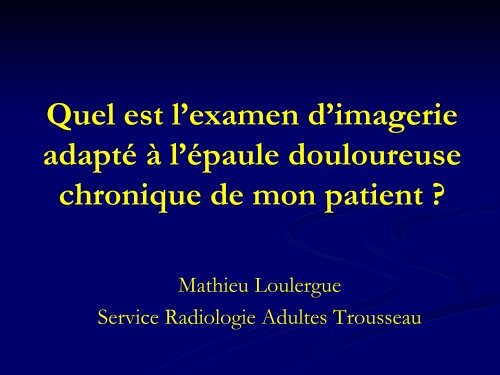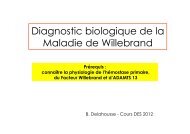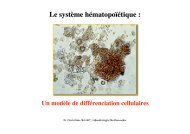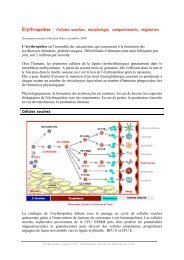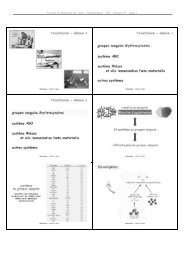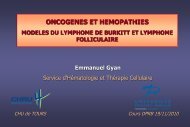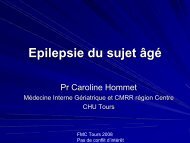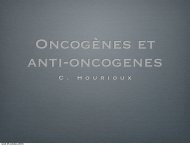Epaule-douloureuse.pdf - FMC de Tours
Epaule-douloureuse.pdf - FMC de Tours
Epaule-douloureuse.pdf - FMC de Tours
You also want an ePaper? Increase the reach of your titles
YUMPU automatically turns print PDFs into web optimized ePapers that Google loves.
Quel est l’examen d’imagerie<br />
adapté<br />
à<br />
l’épaule <strong>douloureuse</strong><br />
chronique <strong>de</strong> mon patient ?<br />
Mathieu Loulergue<br />
Service Radiologie Adultes Trousseau
<strong>Epaule</strong> <strong>douloureuse</strong>: état <strong>de</strong>s lieux<br />
Plusieurs imageries disponibles:<br />
radiographies, échographie, arthro-TDM, IRM, arthro-IRM<br />
Aucune étu<strong>de</strong> controlée validée dans le recours aux<br />
investigations complémentaires pour la prise en charge<br />
initiale <strong>de</strong> l’épaule <strong>douloureuse</strong><br />
Recommandations pour la pratique clinique ANAES<br />
2004
Objectifs<br />
Lequel <strong>de</strong>man<strong>de</strong>r en premier pour mon patient ?<br />
(Quel(s) renseignement(s) peut-on attendre <strong>de</strong> chaque<br />
examen d’imagerie)
1ère étape: examen clinique<br />
Interrogatoire (âge, profession, antécé<strong>de</strong>nts douloureux)<br />
Inspection<br />
articulations acromio et sterno-claviculaire<br />
« boule » bicipitale<br />
amyotrophie<br />
Palpation<br />
articulation acromio-claviculaire<br />
gouttière bicipitale<br />
angle antéro-externe acromion (tendon sus-épineux)
1ère étape: examen clinique (2)<br />
Mobilités articulaires<br />
passives<br />
actives<br />
Testing musculaire<br />
diminuées dans les ruptures <strong>de</strong> la coiffe <strong>de</strong>s rotateurs<br />
manœuvre <strong>de</strong> Jobe (sus-épineux)<br />
cou<strong>de</strong> au corps: rotation externe (sous-épineux), rotation<br />
interne (sous-scapulaire)<br />
déformation en boule du biceps (chef long du biceps)
2è<br />
étape: radiographies standards<br />
INCONTOURNABLES +++ avant toute autre<br />
<strong>de</strong>man<strong>de</strong> d’imagerie complémentaire<br />
face 3 rotations et profil sous-acromial<br />
Externe Neutre Interne
Mobilités passives diminuées<br />
atteinte ARTICULAIRE ou CAPSULAIRE ?
Mobilités passives normales<br />
mobilités actives diminuées + testing anormal<br />
défilé sous-acromial aminci ( < 7mm) = larges ruptures<br />
transfixiantes anciennes
Mobilités passives normales<br />
mobilités actives normales + testing normal (épaule<br />
<strong>douloureuse</strong> simple)<br />
atteinte acromio-claviculaire ?
Mobilités passives normales<br />
mobilités actives normales + testing normal (épaule<br />
<strong>douloureuse</strong> simple)<br />
morphologie arche acromio-claviculaire (conflits antérieur et<br />
antéro-supérieur)
3è<br />
étape: Imagerie complémentaire<br />
QUAND ?<br />
LAQUELLE ?
QUAND ?<br />
testing anormal + mobilités actives normales ou<br />
diminuées + espace sous-acromio-huméral > 7mm<br />
contexte éventuel <strong>de</strong> rupture <strong>de</strong> coiffe réparable<br />
chirurgicalement<br />
si imagerie normale: EMG++ (compression du nerf<br />
sus-scapulaire)<br />
mobilités actives et testing normaux (épaule<br />
<strong>douloureuse</strong> simple)
Arthro-TDM ?<br />
Echographie ?<br />
IRM ?<br />
Arthro-IRM ?<br />
LAQUELLE ?
Arthro-TDM<br />
nécessite injection intra-articulaire <strong>de</strong> produit <strong>de</strong> contraste<br />
très bonne résolution spatiale<br />
qualité constante même chez patients âgés, dyspnéiques et<br />
claustrophobes ( contrairement à l’IRM)
Arthro-TDM<br />
très bon examen en cas <strong>de</strong> rupture transfixiante d’un tendon<br />
bonne évaluation <strong>de</strong> la dégénérescence graisseuse <strong>de</strong>s corps<br />
musculaires
Arthro-TDM<br />
examen incomplet en cas <strong>de</strong> rupture non transfixiante<br />
analyse du versant articulaire uniquement: examen normal<br />
possible même en présence d’une lésion superficielle <strong>de</strong> la<br />
coiffe, d’une bursite
Echographie<br />
analyse versants articulaire et bursale <strong>de</strong> la coiffe<br />
épanchement intra-articulaire et bursite<br />
association en aiguë: lésion transfixiante <strong>de</strong> la coiffe
pathologies tendineuses:<br />
Echographie<br />
ruptures transfixiantes, partielles
Echographie<br />
tendinopathie du chef long du biceps
Echographie<br />
Calcification: caractères actifs<br />
fragmentation<br />
hypervascularisation (irritation tendineuse)
Echographie<br />
conflits antéro ant ro-sup supérieur, rieur, antérieur: ant rieur:<br />
manœuvres man uvres dynamiques ++
Echographie<br />
non invasif et non irradiant<br />
examen bilatéral possible (lésions asymptomatiques<br />
fréquentes)<br />
examen difficile: opérateur et échographe dépendant
non irradiant<br />
IRM<br />
diagnostic fiable <strong>de</strong>s larges ruptures <strong>de</strong> coiffe
IRM<br />
Evaluation: muscles, tendons, surfaces articulaires, os
IRM<br />
Limitée pour le diagnostic <strong>de</strong>s lésions partielles et clivages<br />
intra-tendineux (pas <strong>de</strong> distension articulaire)<br />
Analyse difficile tendon du sous-scapulaire et du chef long<br />
du biceps
Arthro-IRM<br />
Injection intra-articulaire augmente la résolution spatiale
1 ère INTENTION:<br />
LAQUELLE ?<br />
ECHOGRAPHIE et/ou IRM ( examens non invasifs)<br />
EPAULE DOULOUREUSE SIMPLE:<br />
ECHOGRAPHIE ++<br />
Tendinopathie du long biceps<br />
Conflits++ ( manœuvres dynamiques)<br />
Arthro-TDM ou Arthro-IRM complémentaire si<br />
besoin
LAQUELLE?<br />
Bilan pré-opératoire rupture <strong>de</strong> coiffe:<br />
Arthro-TDM:<br />
patients âgés, dyspnéiques et claustrophobes<br />
rupture transfixiante<br />
Arthro-IRM:<br />
si possible…
Conclusion<br />
1ère étape: examen clinique (mobilités, testing)<br />
2è étape: radiographies standards<br />
INCONTOURNABLES +++ avant toute autre <strong>de</strong>man<strong>de</strong><br />
d’imagerie complémentaire<br />
3è étape: imagerie complémentaire dans 2 situations<br />
épaule <strong>douloureuse</strong> simple ( échographie +++)<br />
contexte éventuel <strong>de</strong> rupture <strong>de</strong> coiffe réparable chirurgicalement<br />
(testing anormal + mobilités actives normales ou diminuées +<br />
espace sous-acromio-huméral > 7mm) ( Arthro- IRM ou TDM)


